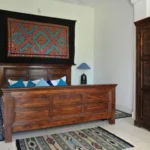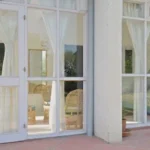Sanjharia, Ajmer Road, Jaipur -302042 INDIA
Check Availability This Room








From
$179.0
Night








The décor for this room is a mosaic of different shades of blue, dominated by the brilliant hue of the Lapis Lazuli. The king-sized bed is antique Rajasthani as are the carved wardrobe and chest. The bedroom has an additional glass enclosed sitting room that has a vista of gardens, groves of trees and undulating cropland. The room has its own patio.
The choice of the name Lapis Lazuli celebrates the cultural impact of the blue colour of the Lapis on the handicrafts of Jaipur. It can be seen in the unique blue handmade pottery, in the handmade ornamental ceramic tiles, in the traditional enameled jewellery worn by the elite (meenakari) that uses powdered Lapis in the enamelling process, in the miniature paintings on silk which, too, use powdered precious and semi-precious stones including the Lapis, in the strings of faceted and polished Lapis beads that abound in Jaipur’s bazaars, and rings and pendants of Lapis set in silver that is one of the traditional jewellery crafts of Jaipur. And much more.
The Lapis Lazuli (often abbreviated to Lapis) is a relatively rare semi-precious stone prized since antiquity for its intense blue colour. Lapis is the Latin word for stone. And Lazuli comes from the medieval Latin “lazulum”, which in turn is from the Persian “lazaward”, taken from the place where the stone was mined in Persia (Lazhaward). Lazaward also means sky or heaven or blue. Thus “sky-stone” or “stone of heaven” or “stone of lazhaward.
As early as the 3rd. millennium B.C. (more than 6000 years ago) Lapis Lazuli was being mined in the Badakshan province of Afghanistan (in the Hindukush mountains). And trade in the stone was ancient enough for Lapis jewellery to have been found in pre-dynastic Egyptian and ancient Sumerian sites. Lapis beads have been found at neotlithic burials in Mehrgarh in modern day Baluchistan, believed to be the world’s oldest (over 7000 years old) city that pre-dated the Indus Valley Civilisation. Lapis remains have been found in excavations even as far from Afghanistan as Mauritania.
While Afghanistan was the source of the stone for ancient Egypt and Sumeria, and later for ancient Greece and Rome, Lapis has also been extracted for long from mines in India, Pakistan, Burma, Angola, Argentina, Siberia, Canada, Russia and the U.S.
Lapis takes an excellent polish and can be made into jewelry, carvings, boxes, mosaics, ornaments, and vases. It was the stone of choice for these uses in most ancient civilisations. Its use in inlay work in marble architecture was most notably in the Taj Mahal, and in the mosaics used in domes of mosques of central Asia.
It was also ground and processed to make the pigment ultramarine (meaning a blue that is “beyond the seas”) for tempera paint and, more rarely, for oil paint used to create the luminous blues of sea and sky and the Madonna’s blue cloak from the Renaissance right up to the 19th. century, in the illuminated manuscripts of Central Asia and Mughal India and, in traditional miniature paintings on silk in medieval Rajasthan. In Europe, its usage as a pigment in oil paint ended in the early 19th century when a chemically identical synthetic variety, often called French ultramarine, became available.
Powdered Lapis used on the eyelids was believed to have health benefits for the eyes as well as enhance their beauty, as shown on ancient Egyptian figures.
Most importantly in the ancient world, the Lapis was seen as a powerful stone – and for this reason even more highly valued than gold – and, therefore, to be used with care. Perhaps because it was the bluest of all stones, and came closest to the deepest blue of the skies (heaven) and of the seas, it became a symbol of total awareness, inner truth, a vehicle to help the wearer achieve awareness, insight, intellect and wisdom. And, in ancient Egypt and Sumeria, it was seen as a protection even in death and the afterlife.
Even today, the finest source for the highest quality Lapis is the same deposits in Afghanistan that have been mined for thousands of years.
Jaipur/Rajasthan’s significant historical links with Afghanistan go back to the early 13th. century when northern India in general and the Rajput kingdoms in particular began to see waves of invasion by Afghan marauders. By the 16th. century large parts of north India were firmly under the rule of people of Afghan origin in what came to be known as the Delhi Sultanate. The cultural impact of this encounter must have been considerable. A small reverse process was witnessed recently when jewellery workers from Jaipur with expertise in inlay work were invited to Kabul to help revive and strengthen the traditional Afghan jewellery crafts that had fallen into decline.
Check-in/check-out: 12 noon.
For availability and reservations, please write directly to [email protected].
Main features:
Stunning, uniquely-designed, airy rooms with plenty of natural light and views of greenery all around.
Carefully selected handmade / restored Rajasthani furniture and artifacts, or a blend of traditional and modern furniture.
Very comfortable beds for the best possible sleep.
Restored colonial / traditional Indian / contemporary writing desk in most rooms.
Every room has either a sun terrace, or an additional glass-enclosed sitting room / patio with gorgeous views of the outdoors, or an attached balcony overlooking the pool. A few have fireplaces.
Room and bathroom windows can be opened to let in fresh air when preferred.
All bathrooms are ensuite, have hot and cold running water and rain showers, and views of tree-tops.
Facilities:
- Complimentary breakfast;
-
Tea / Coffee making facility;
-
Pure, natural drinking water from Savista’s borewells (complimentary bottled water on request);
-
Complimentary nibbles;
- Free wireless internet;
- Air conditioning;
- Space heating in chilly weather;
- Sumptuous duvet and high quality cotton bed linen;
- Hundred percent cotton towels, robes and room slippers;
- Branded herbal bath products.
Other Facilities:
- Business services (scanning, copying, printing);
- Laundry and ironing*;
- Hair dryer;
- Concierge service;
- Maps and travel guides;
- Medicines, germicide gargle, sewing accessories etc. (an “Ask For” menu is placed in each room. If you require some other service that is not listed, please ask and we will try our best to arrange it for you);
- Doctor/dentist appointments and facilitation;
- For guests with physical disabilities, one room can be outfitted to suit their needs. Please let us know when booking.
(* chargeable)
N.B.
Most rooms feature a large double bed (king-size), and are for single/double occupancy;
Five rooms can be adapted into twin-bedded rooms (please let us know when you are specifically looking for a twin room;
A child below 4 stays free if sharing the parents’ bed;
Children of 4 and above require an extra bed. Four of our rooms can accommodate an extra rollaway bed (for a child only) for a small extra charge. Please email us with your requirement and we will help you make your selection;
All our guest rooms are non-smoking;
We are a pet-free property;
We do not have T.V.s or intercoms in the rooms;
We accept Visa and Master credit cards, Bank to bank transfers and cash payments (we do not accept Amex cards).
No hidden costs: No resort fees and other vague charges; No workout charges; No towel replacement costs; No wi-fi costs; No parking fees; No breakfast bills.
Be the first to review “Lapis Lazuli”
You must be logged in to post a comment.
Regular plan
| Mon | Tue | Wed | Thu | Fri | Sat | Sun |
|---|---|---|---|---|---|---|
| $179.0 | $179.0 | $179.0 | $179.0 | $179.0 | $179.0 | $179.0 |


Reviews
There are no reviews yet.